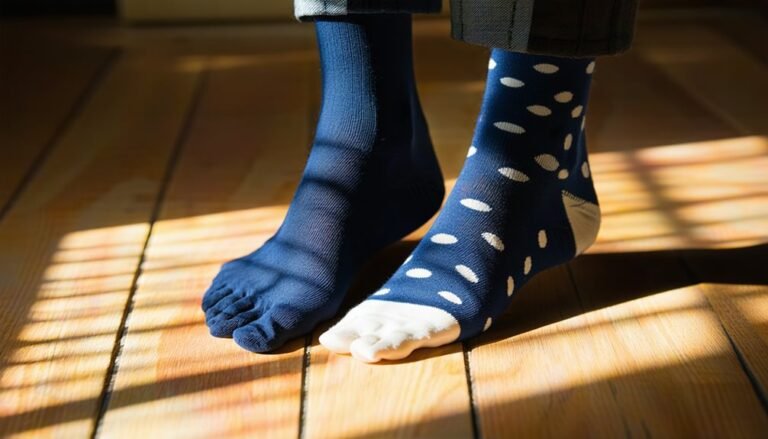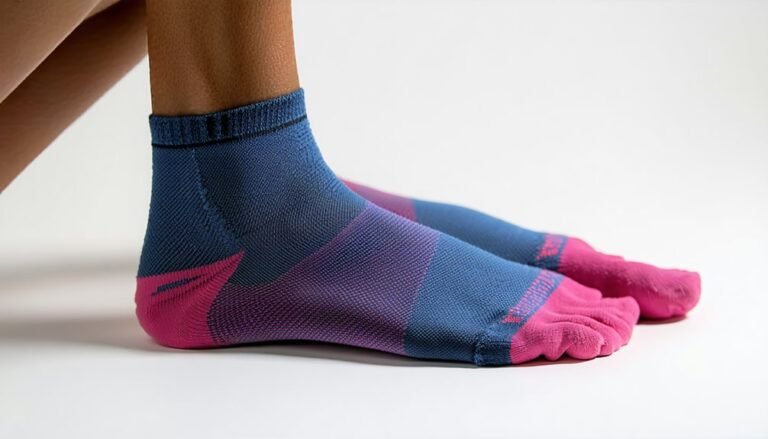How Long Can You Wear Compression Socks?
You can wear compression socks throughout the day to boost circulation and reduce swelling, but you should remove them before sleeping unless advised by a healthcare professional. Compression socks work best during periods of activity with the right compression level guaranteeing comfort without numbness or tingling. Signs of over-wearing include discomfort or skin indentations, prompting a shorter wear time. With the right guidance, you'll assure both effectiveness and safety, greatly benefiting from additional insights.
Understanding Compression Sock Technology

When it comes to understanding compression sock technology, it's vital to recognize how these specially designed garments work to improve your circulation and overall leg health. Compression socks are crafted from advanced materials like spandex, nylon, and elastane, which provide elasticity and durability. The fabric's quality guarantees that the socks maintain their shape and effectiveness over time, offering a snug yet comfortable fit.
The core of their function lies in the pressure gradient design, which exerts graduated pressure on your legs. This means the compression is highest at the ankle and gradually decreases as it moves up the leg. This design promotes blood flow back to your heart, reducing swelling and the risk of circulatory issues. Remember, choosing the right materials and design is vital for your safety.
The Benefits of Wearing Compression Socks
When you wear compression socks, you're supporting your circulatory system by enhancing blood flow, which can be essential for maintaining overall vascular health. This improved circulation not only reduces the risk of swelling and discomfort, especially if you're on your feet for long periods, but it also contributes to better athletic performance by delivering more oxygen to your muscles. Whether you're managing a medical condition or seeking an edge in your fitness routine, compression socks offer tangible benefits that align with your health and performance goals.
Improved Blood Circulation
The marvel of improved blood circulation is one of the most significant benefits of wearing compression socks. By applying gentle pressure on your legs, these socks enhance blood flow, promoting circulation benefits that contribute to your overall health. This increased efficiency in blood movement helps prevent complications like deep vein thrombosis and varicose veins, guaranteeing you feel secure and cared for.
| Benefit | Description | Safety Aspect |
|---|---|---|
| Blood Flow | Enhances movement of blood | Reduces risk of clotting |
| Circulation Benefits | Supports cardiovascular health | Promotes vein integrity |
| Comfort | Provides daily wearability | Guarantees long-term use safety |
Understanding these benefits, you're empowered to make informed decisions about incorporating compression socks into your routine, knowing they prioritize your health and safety.
Reduced Swelling Risk
Beyond improved circulation, compression socks also offer the benefit of reducing swelling, an issue many people face daily. Whether you're standing for extended periods or sitting on long flights, swelling management becomes essential. Compression benefits are achieved as these socks apply consistent pressure to your legs, preventing fluid buildup. This pressure aids in pushing blood and lymphatic fluids back towards the heart, minimizing swelling effectively.
For those with conditions like edema or varicose veins, the structured support of compression socks can be a game-changer. You'll notice a significant reduction in discomfort and an increase in mobility, promoting a safer daily routine. By incorporating compression socks into your lifestyle, you're actively taking steps to manage swelling risks, ensuring both comfort and health are prioritized.
Enhanced Athletic Performance
If you're looking to boost your athletic performance, incorporating compression socks into your gear can offer substantial benefits. These socks are designed to enhance performance by improving blood flow, which helps deliver oxygen to your muscles more efficiently. This can lead to reduced muscle fatigue and quicker athletic recovery, allowing you to train harder and safer.
Consider the following benefits:
| Benefit | Explanation |
|---|---|
| Improved Circulation | Increases oxygen delivery to muscles, aiding performance enhancement. |
| Reduced Fatigue | Lessens muscle strain, allowing longer, safer workouts. |
| Enhanced Recovery | Accelerates muscle recovery post-exercise, minimizing downtime. |
| Injury Prevention | Supports muscles and joints, reducing the risk of strains and injuries. |
Recommended Duration for Daily Wear
While it might seem straightforward, determining how long to wear compression socks each day requires some consideration of your individual needs. It's essential to understand that different compression sock styles and materials can influence wear time. Generally, you can wear them throughout the day, especially if you're on your feet or sitting for extended periods. However, it's important to remove them before sleeping unless advised by a healthcare professional.
The snug fit of compression socks can help promote blood circulation and reduce swelling, but they shouldn't cause discomfort. If you feel any pain or tingling, take them off immediately. Always consult a healthcare provider to tailor the duration to your specific health concerns, ensuring you're maximizing benefits while maintaining safety.
Factors Affecting Wear Time

When considering how long to wear compression socks, several factors can influence the ideal duration for each individual. It's crucial to evaluate your personal comfort and individual tolerance. Everyone's body reacts differently; what feels right for one might not suit another. Monitor how your legs feel throughout the day. If swelling or discomfort arises, it may be time to remove the socks. Furthermore, your medical condition plays a significant role. Those with specific circulatory issues might need to wear them longer than someone using them for general support. Additionally, environmental factors like temperature and humidity can impact comfort levels. Always prioritize your safety and well-being by listening to your body's signals and adapting usage accordingly.
Signs You've Worn Them Too Long
Although compression socks are designed to promote circulation and prevent discomfort, wearing them for too long can have adverse effects. It's vital to recognize the signs of discomfort, which may indicate that it's time to remove them. Pay attention to numbness, tingling, or a noticeable indentation on your skin. These symptoms can suggest excessive compression or extended length of usage beyond what's beneficial.
Here's a quick reference table:
| Symptom | Possible Cause | Action |
|---|---|---|
| Numbness | Excessive compression | Remove socks immediately |
| Tingling | Poor circulation | Adjust wear time |
| Skin indentation | Extended wear | Shorten usage period |
Day vs. Night Use: What You Need to Know
When considering whether to wear compression socks during the day or night, it's crucial to weigh the unique benefits and considerations of each. During the day, these socks can enhance circulation and reduce swelling while you're active, but at night, the need for compression might differ based on your medical condition and comfort level. Ideally, your wear duration should align with your daily activities and any medical advice you've received, ensuring maximum comfort and effectiveness.
Daytime Benefits Explained
While the benefits of wearing compression socks are well-documented, understanding the difference between daytime and nighttime use is essential for maximizing their effectiveness. During your daytime activities, compression socks can greatly improve circulation, reduce swelling, and enhance overall leg comfort. The right sock materials, such as breathable fabrics, guarantee that your legs remain cool and comfortable, even during extended wear.
Whether you're standing for long periods or sitting at a desk, these socks provide the necessary support to prevent fatigue and promote vascular health. Safety is a priority, and wearing them during the day helps mitigate risks associated with prolonged immobility, such as deep vein thrombosis. Remember, selecting the appropriate compression level tailored to your specific needs is key for ideal daytime benefits.
Nighttime Considerations Discussed
Despite the many benefits of compression socks during the day, nighttime use requires careful consideration to ascertain safety and effectiveness. It's important to evaluate whether wearing them overnight will enhance your nighttime comfort and sleep quality. Compression levels, personal health needs, and conditions like venous insufficiency dictate if night use is suitable. While some find relief from swelling and discomfort by wearing them at night, others might experience restricted blood flow if the socks are too tight. Consult your healthcare provider to understand your specific requirements. If deemed appropriate, verify the socks are properly fitted to prevent circulation issues. Remember, your safety is paramount, and the goal is to enhance, not hinder, your overall well-being during sleep.
Ideal Wear Duration
Understanding the ideal wear duration for compression socks involves balancing the benefits of daytime use with considerations for nighttime wear. During the day, compression socks provide essential support, improving circulation and reducing swelling. This is particularly beneficial if you're on your feet for long periods or have a sedentary job. For ideal usage, verify an excellent fit by measuring your legs correctly and choosing the right compression level.
At night, wearing compression socks isn't typically recommended unless advised by a healthcare professional. While some individuals with specific conditions might benefit from nighttime use, most should allow their skin to breathe, preventing potential discomfort or skin issues. Always prioritize your safety and consult with a professional to tailor your compression sock routine to your unique needs.
Compression Levels and Their Impact on Wear Time

Although compression socks are a well-recognized tool in managing various circulatory and leg health issues, the compression level you choose considerably impacts how long you should wear them. Knowing the right compression levels guarantees effectiveness and safety. Lower compression levels (15-20 mmHg) are typically safe for extended wear, but higher levels (20-30 mmHg or above) might require shorter durations. Your comfort and needs should guide wear time.
- Mild Compression (8-15 mmHg): Suitable for all-day wear, ideal for travel or standing jobs.
- Moderate Compression (15-20 mmHg): Often recommended for minor swelling or fatigue.
- Firm Compression (20-30 mmHg): Used for more pronounced symptoms, best worn under medical advice.
- Extra Firm Compression (30-40 mmHg): Reserved for specific medical conditions, professional guidance necessary.
Always prioritize comfort and consult healthcare professionals if unsure.
Considerations for Different Medical Conditions
Choosing the right compression level isn't the only factor influencing wear time. Specific medical conditions also dictate how long you should wear compression socks. If you're managing diabetes, it's essential to guarantee proper fit and monitoring to avoid skin complications. Pregnancy support often requires extended wear to alleviate swelling, but comfort should guide your duration. For individuals with venous insufficiency, consistent wear is recommended to maintain blood flow and reduce discomfort. Post-surgery recovery might necessitate wearing compression socks for several hours or even all day to prevent blood clots and enhance healing. Always consult with your healthcare provider to tailor your wear time to your specific needs, ensuring safety and maximizing the benefits of your compression socks.
Tips for Comfort and Effectiveness
To maximize the comfort and effectiveness of your compression socks, it's important to confirm they fit properly and are donned correctly. Begin with sock selection, focusing on materials that breathe well and offer durability. Proper sizing is vital; too tight and you'll risk circulation issues, too loose and they won't function effectively. Consider these tips for enhanced comfort and effectiveness:
- Measure your legs in the morning when swelling is minimal to verify accurate sizing.
- Choose graduated compression for consistent pressure, enhancing circulation safely.
- Rotate pairs daily to maintain elasticity and hygiene, promoting longevity.
- Check for skin reactions regularly, noting any discomfort or redness that might indicate improper fit or sensitivity.
Following these guidelines guarantees both safety and maximum benefit.
When to Consult a Healthcare Professional
While guaranteeing your compression socks fit well and serve their purpose, it's equally important to recognize when professional guidance is necessary. If you experience discomfort, unusual swelling, or skin changes, it's time to seek professional advice. Consulting a healthcare professional guarantees safety and effectiveness. Understanding specific consultation guidelines can make a significant difference in your health journey.
Here's when to consult a professional:
| Symptom | Immediate Action Required | Professional Advice Needed |
|---|---|---|
| Persistent pain | Yes | Yes |
| Skin discoloration | Yes | Yes |
| Numbness | Yes | Yes |
| Increased swelling | Yes | Yes |
| Circulation issues | Yes | Yes |
Prioritizing your health involves understanding when to seek help. Trust your instincts, and guarantee you're receiving the right support. Your well-being is paramount.
Frequently Asked Questions
Can Compression Socks Be Worn During Exercise or Sports Activities?
Yes, you can wear compression socks during exercise. They offer performance benefits by enhancing circulation and reducing muscle fatigue. Additionally, they aid in injury prevention by providing support and minimizing strain, ensuring a safer workout experience.
How Do Different Materials Impact the Comfort of Compression Socks?
Imagine your feet as travelers on a journey; the material types and sock thickness are their companions. Choose wisely, as breathable fabrics like cotton offer comfort, while synthetic blends guarantee durability, balancing comfort and safety during your travels.
Are There Specific Brands Recommended for Long-Term Wear?
When exploring brand comparisons for long-term wear, you'll find user testimonials highlighting brands like Sigvaris and Jobst. They're praised for durability and comfort, ensuring safety and reliability. Always choose based on verified experiences and expert recommendations.
Do Compression Socks Require Special Washing and Care Instructions?
Yes, compression socks need special care. Use gentle washing techniques, like hand washing or a delicate machine cycle. For care tips, avoid fabric softeners and dry them flat. This guarantees your socks' longevity, maintaining their effectiveness and safety.
Can Compression Socks Be Worn in Hot or Humid Climates?
In hot or humid climates, 60% of users report discomfort. You'll need to take into account humidity effects and temperature factors, opting for lightweight, moisture-wicking materials to guarantee safety and comfort. Remember, your well-being should always come first.







